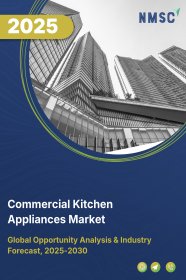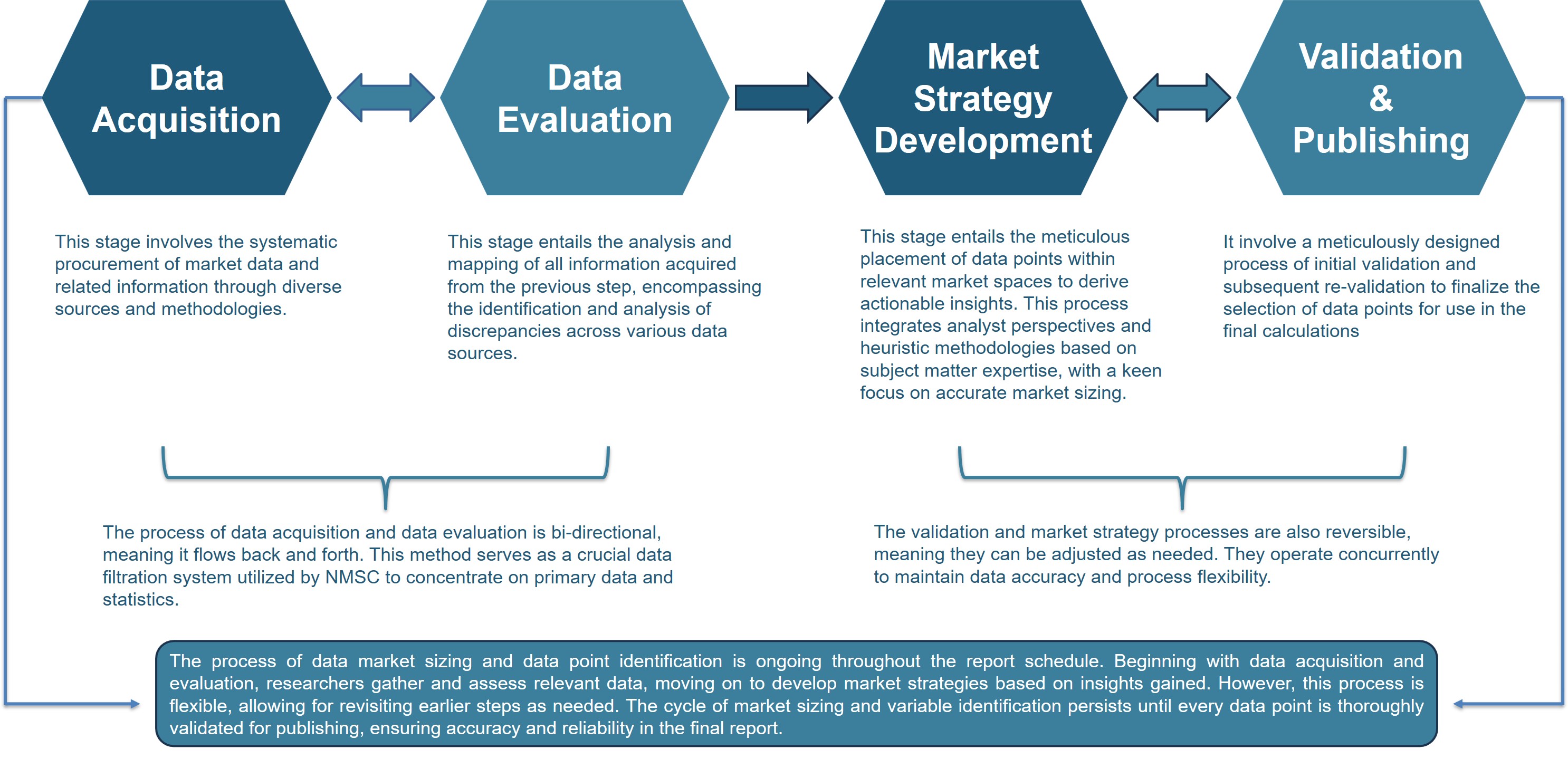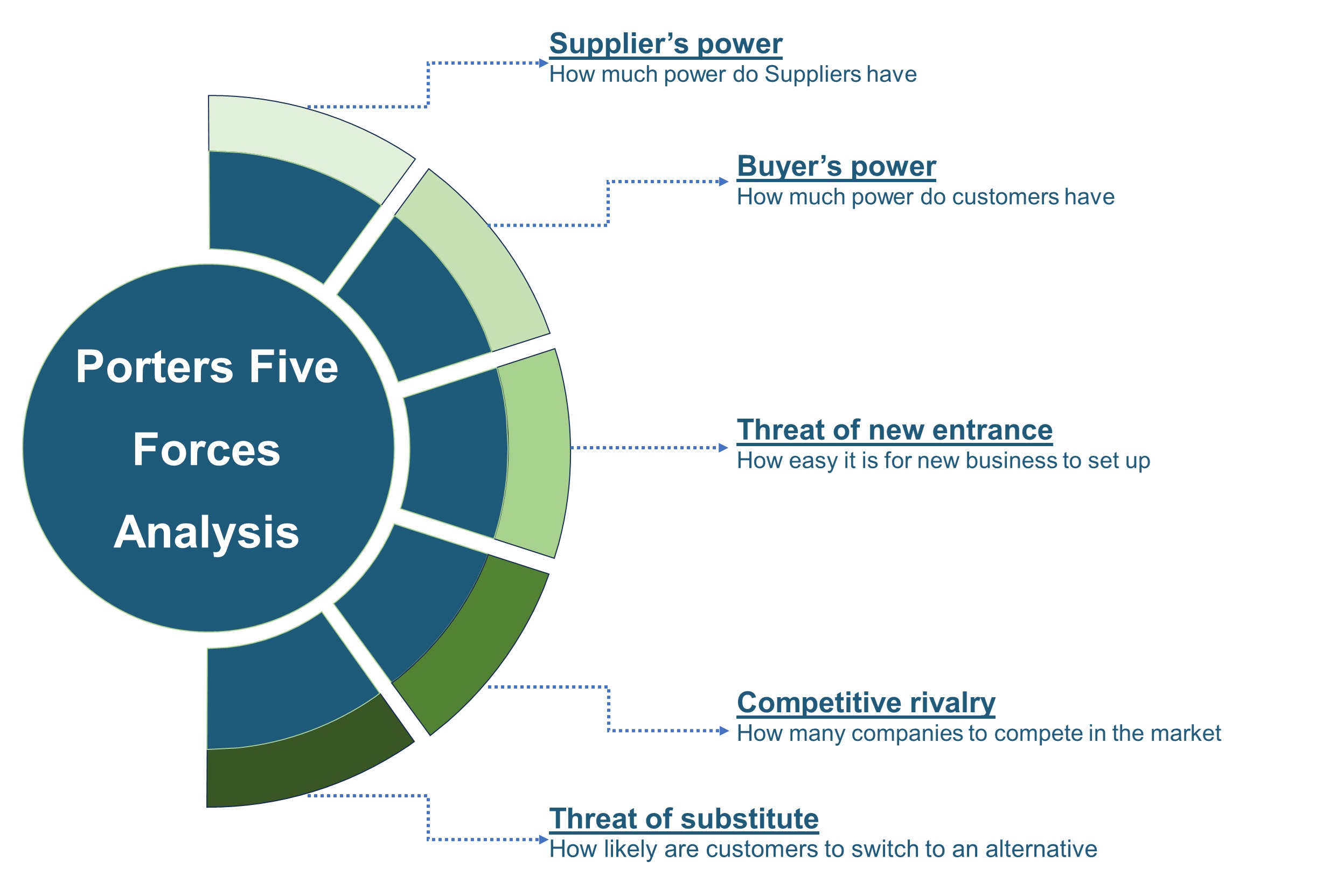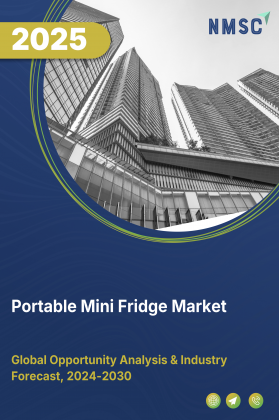
Commercial Kitchen Appliances Market Size by Product Types (Refrigeration, Cooking Appliances, Food Prep, Dishwashers, Ventilation, Storage, and Others), by Equipment Size (Small, Medium, and Large), by Fuel Types (Electric, Gas, Hybrid, and Induction), by Distribution Channels (Online, and Offline), by Product Structure (Built-in, and Free-Stand), by End Users (Foodservice, Hospitality, Institutions, Retail Kitchens, and Others) – Global Opportunity Analysis and Industry Forecast, 2025–2030
Industry Overview
The global Commercial Kitchen Appliances Market size was valued at USD 101.7 billion in 2024, and is expected to be valued at USD 108.1 billion by the end of 2025. The industry is projected to grow, hitting USD 146.2 billion by 2030, with a CAGR of 6% between 2025 and 2030.
The commercial kitchen appliances market, a vital segment within the broader commercial foodservice equipment industry, is experiencing substantial growth driven by three key trends: the growing global food service & hospitality sector, a rising demand for high-efficiency equipment driven by operational cost concerns, and growing hygiene and safety regulations.
However, the market size faces headwinds from restraints like the high initial investment costs associated with advanced equipment prices. Despite these challenges, lucrative opportunities exist, particularly in the widespread adoption of kitchen automation solutions and the significant growth potential in emerging economies, promising a vibrant future for key players seeking to capture greater market share.
Expansion of Food Service & Hospitality Drives the Growth of the Market
One of the most potent driving factors for the commercial kitchen appliances market growth is the relentless expansion of the global foodservice sector. There is a dramatic shift in consumer behaviour, with increasing disposable incomes, accelerated urbanization, and evolving lifestyles leading more people to dine out, opt for quick-service restaurants (QSRs), or rely on the convenience of online food delivery and cloud kitchens.
According to the United States Census Bureau the total U.S. retail and food services sales in April 2025 stood at USD 724.1 billion, up 5.2% from April 2024. This includes “food services and drinking places” and reflects growing consumer spending on dining out and delivery compared with a year earlier. This continuous growth in out-of-home food consumption serves as the foundational demand generator for the entire industry.
The Drive for Energy Efficiency and Sustainability Boosts the Growth of the Market
In an era of escalating energy costs and heightened environmental consciousness, the push for energy-efficient and sustainable commercial kitchen appliances has become a critical market driver. Manufacturers are responding with innovations such as induction cooking, advanced insulation in refrigeration units, and intelligent power management systems that drastically cut down electricity, water, and gas consumption.
Beyond cost savings, there's a growing regulatory push and consumer preference for "green" practices, encouraging businesses to adopt eco-friendly materials and equipment with lower carbon footprints. For instance, the U.S. EPA's ENERGY STAR program highlights that certified foodservice equipment leads to substantial annual savings, making these appliances not just an environmental choice, but a financially astute investment for operators.
Hygiene and Safety Regulations Further Drive the Market Expansion
Stringent hygiene and safety regulations are significantly influencing the commercial kitchen appliances market expansion, prompting operators to upgrade to equipment that meets modern compliance standards. Regulatory frameworks such as the European Union’s Regulation on the hygiene of foodstuffs and similar national-level standards in North America and Asia enforce strict requirements for cleanliness, material safety, and ease of sanitization in professional kitchens.
For instance, The European Food Safety Authority reports in 2023 states that in 2022 there were 5,763 foodborne outbreaks across EU Member States resulting in 48,605 cases and 64 deaths up 44% from 2021, which highlights both the persistence of risk and the urgent need for appliances that facilitate compliance with stringent cleaning, disinfection, and monitoring protocols.
These mandates necessitate the use of stainless-steel surfaces, seamless designs to prevent food residue buildup, and appliances that support temperature control and contamination prevention. As health agencies tighten oversight, especially in post-pandemic environments, foodservice establishments are compelled to invest in appliances that ensure food safety, traceability, and compliance, thereby fuelling steady growth for hygienically optimized kitchen solutions.
High Initial Investment Costs Hinders Market Expansion
Despite the clear long-term benefits of modern commercial kitchen appliances, one of the most substantial restraints on market growth, particularly for small and medium-sized enterprises (SMEs) and new ventures, is the high initial investment required. The energy-efficient and smart kitchen equipment comes with a significant upfront cost of 40-50% higher than traditional alternatives.
Many smaller businesses simply lack the substantial capital needed for such an outlay, which slows down the adoption of advanced technology and limits their ability to modernize operations. This financial hurdle forces businesses to opt for less efficient, older equipment or to delay necessary upgrades, thereby impacting the overall market's growth trajectory.
Integration of AI into Appliances Creates Future Growth Opportunities
The growing adoption of automation in commercial kitchens is driven by escalating labour costs, staff shortages, and consumer demand for consistent, high-quality, fast food. Robotics, from cooking appliances to smart ovens and dishwashers, is now central to operations, enabling businesses to reduce manual labour, improve consistency, and boost efficiency.
Quick-service and high-volume catering operations benefit most, gaining a competitive edge in throughput and customer satisfaction. With AI and machine learning, systems are becoming adaptive, optimizing processes in real-time and enabling predictive maintenance and intelligent inventory management.
Market Segmentations and Scope of the Study
The commercial kitchen appliances market report is segmented by product type, size, fuel type, distribution channel, product structure, and end user. Product types include refrigeration equipment (stand-alone refrigerators, cook-chill systems), cooking appliances (ovens, broilers, cooktops, grills, fryers), food preparation tools (mixers, slicers), dishwashers, ventilation systems, storage and handling units (warming cabinets, transport carts), and others. Equipment is categorized by size into small-scale (benchtop, portable), medium-scale (floor-standing, non-industrial), and large-scale (industrial, high-capacity). Fuel types include electric, gas, hybrid, and induction. Distribution channels are online (e-commerce, direct web sales) and offline (dealers, distributors, direct sales). Products are structured as built-in or free-standing. End users include foodservice outlets (full-service and quick-service restaurants), hospitality (hotels, resorts), institutions (hospitals, schools, canteens), retail kitchens (in-store and cloud kitchens), contract caterers (catering companies, railway dining), and others. Regional breakdown and analysis of each of the aforesaid segments includes regions comprising North America, Europe, Asia-Pacific, and Rest of the World (RoW).
Geographical Analysis
North America continues to lead the commercial kitchen appliances market share, driven by a strong emphasis on energy-efficient refrigeration units and smart cooking equipment. This trend is largely influenced by the need to comply with federal efficiency standards and strict food safety regulations.
In line with this, the U.S. Department of Energy (DOE) issued a new rule in January 2025, establishing updated energy conservation standards for a range of products, including commercial refrigerators, freezers, and refrigerator-freezers, collectively referred to as commercial refrigeration equipment (CRE).
Under the Energy Policy and Conservation Act (EPCA), the DOE is also mandated to periodically review these standards to assess whether more stringent requirements are technologically viable, economically reasonable, and capable of delivering substantial energy savings. These regulatory changes are directly impacting the commercial kitchen appliances market by pushing manufacturers and operators to adopt equipment that meets the new energy efficiency criteria.
In Europe, the market is increasingly shaped by a strong focus on sustainability and total cost of ownership. Reflecting this momentum, in May 2025, the European Commission’s Directorate-General for Energy launched four calls for evidence to revise the eco-design and energy-labelling requirements for refrigerating appliances, including those with and without a direct-sales function. This review, mandated under the new Eco-design for Sustainable Products Regulation (ESPR), will assess key sustainability factors such as the use of natural refrigerants, as well as the durability, repairability, recyclability, and overall environmental impact of products throughout their lifecycle.
With stricter rules expected by 2026, these evolving standards are driving manufacturers to innovate, ensuring their products meet not only regulatory compliance but also rising consumer and industry expectations for eco-friendly, long-lasting solutions. This regulatory push is not only reshaping product development but also reinforcing Europe's transition toward greener, more cost-efficient commercial kitchen solutions.
Asia-Pacific is the fastest-growing segment in the global commercial kitchen appliances landscape, fuelled by rapid urbanization and expanding cloud-kitchen networks. Governments across the region are offering subsidies and tax incentives for energy-efficient and smart appliances, significantly enhancing growth potential.
For instance, in November 2024, the Indian Ministry of Power announced to launch of an approximately USD 120 million scheme, “Assistance in Deploying Energy Efficient Technologies in Industries & Established (ADEETIE)” to promote energy efficiency in micro-, small-, and medium-enterprises (MSMEs).
Managed by the Bureau of Energy Efficiency (BEE), the scheme will provide interest subvention on loans to encourage the adoption of energy-efficient technologies, helping reduce energy costs and emissions across small-scale operations, including foodservice and commercial kitchen setups. This development will not only reinforce India's commitment to sustainable industrial practices but also reflect a broader shift in the global commercial kitchen appliance market.
In Latin America, the Middle East, and Africa, the commercial kitchen appliances industry is in a phase of gradual modernization and capacity building. While the overall market share remains smaller compared to more mature regions, increasing tourism inflows and the entry of international foodservice brands are driving demand for reliable, mid-range ovens, automated dishwashing units, and refrigerated display cases. Collaborative ventures between local and global manufacturers are introducing cost-effective solutions, setting the stage for accelerated market growth as infrastructure development and regulatory frameworks steadily advance.
Key Development Strategies Adopted by the Key Players of the Industry
The commercial kitchen appliances industry is highly competitive, with leading firms driving innovation and strategic expansion.
-
Middleby Corporation completed multiple strategic acquisitions, including Flavor Burst, and spun off its food-processing division into a standalone public entity. Flavor Burst, which provided flavouring systems for soft serve, shakes, slush, smoothies, frozen carbonated beverages, frozen coffees, and frozen cocktails, enhanced Middleby’s beverage and dessert equipment portfolio. Its integration expanded customization options for commercial kitchens such as quick-service restaurants (QSRs) and cafés. This move aligned with the growing demand for versatile, integrated appliances in the commercial kitchen appliance market, particularly in frozen dessert and beverage preparation.
-
Ali Group acquired JIPA International in January 2025, a Czech Republic-based manufacturer of advanced electrical multifunctional devices for commercial kitchens. The flagship product, JIPA JUMP, performed various cooking functions, including pressure cooking, frying, braising, grilling, and sous vide. This acquisition strengthened Ali Group’s position in the multi-functional electric cooking equipment segment—one that had been expanding due to compact kitchen trends, the need for energy efficiency, and greater operational flexibility.
-
Whirlpool Corporation and BORA introduced revolutionary induction downdraft cooktop technology to North America through a collaboration aimed at delivering this innovation exclusively via JennAir and KitchenAid brand cooktops in 2025. This product catered to modern commercial kitchen layouts by combining sleek design with space-saving downdraft ventilation. It addressed the rising demand in upscale hospitality and boutique restaurant segments for premium, high-performance, and energy-efficient cooking appliances.
-
Miele released its G 5000 Active and Active Plus dishwashers, setting new standards in energy efficiency and delivering a comprehensive upgrade with its most energy-efficient range to date. These new models appealed to environmentally-conscious commercial kitchens seeking sustainable dishwashing solutions, in line with industry trends emphasizing eco-friendly appliances that reduce water and energy consumption.
-
Electrolux acquired Adventys, a French specialist in induction technology that designed and manufactured induction cooking equipment. The acquisition, announced and completed in April 2024, enhanced Electrolux’s portfolio of advanced induction appliances. It supported the company’s strategy to meet increasing demand for induction-based commercial cooking solutions known for faster, safer, and more energy-efficient operations.
Key Benefits
-
The report provides quantitative analysis and estimations of the commercial kitchen appliances industry from 2025 to 2030, which assists in identifying the prevailing market opportunities.
-
The study comprises a deep-dive analysis of the current and future commercial kitchen appliances market trends to depict prevalent investment pockets in the industry.
-
Information related to key drivers, restraints, and opportunities and their impact on the market is provided in the report.
-
Competitive analysis of the key players, along with their market share is provided in the report.
-
SWOT analysis and Porters Five Forces model is elaborated in the study.
-
Value chain analysis in the market study provides a clear picture of roles of stakeholders.
Commercial Kitchen Appliances Market Key Segments
By Product Type
-
Refrigeration Equipment
-
Stand-alone Refrigerators
-
Cook-Chill Systems
-
-
Cooking Appliances
-
Ovens
-
Broilers
-
Cooktops and Ranges
-
Grills
-
Fryers
-
Others
-
-
Food Preparation Equipment
-
Mixers
-
Slicers
-
-
Dishwasher
-
Ventilation
-
Storage & Handling
-
Warming Cabinets
-
Transport Carts
-
-
Others
By Size
-
Small-scale Equipment
-
Medium-Scale Equipment
-
Large-Scale Equipment
By Fuel Type
-
Electric
-
Gas (Natural/LPG)
-
Hybrid (Dual-Fuel)
-
Induction
-
Others
By Distribution Channel
-
Online
-
Offline
By Product Structure
-
Integrated
-
Free-Stand Appliance
By End User
-
Foodservice Outlets
-
Full Services Restaurant
-
Quick Service Restaurant
-
Hospitality
-
Hospitals
-
Retail Kitchens
-
Contract Caterers
-
Railway Dining
-
Resorts & Hotels
-
Other End User
By Region
-
North America
-
The U.S.
-
Canada
-
Mexico
-
-
Europe
-
The U.K.
-
Germany
-
France
-
Italy
-
Spain
-
Denmark
-
Netherlands
-
Finland
-
Sweden
-
Norway
-
Russia
-
Rest of Europe
-
-
Asia-Pacific
-
China
-
Japan
-
India
-
South Korea
-
Australia
-
Indonesia
-
Singapore
-
Taiwan
-
Thailand
-
Rest of Asia-Pacific
-
-
Rest of the World (RoW)
-
Latin America
-
Middle East
-
Africa
-
Key Players
-
Middleby Corporation
-
Ali Group
-
Illinois Tool Works
-
Electrolux
-
Miele
-
Hoshizaki Corporation
-
MEIKO Maschinenbau
-
Alto-Shaam Inc.
-
American Range Corporation
-
Vollrath Company, LLC
-
Vollrath Company, LLC
-
carrier Global Corporation
-
Duke Manufacturing Company
REPORT SCOPE AND SEGMENTATION:
|
Parameters |
Details |
|
Market Size in 2025 |
USD 108.1 Billion |
|
Revenue Forecast in 2030 |
USD 146.2 Billion |
|
Growth Rate |
CAGR of 6% 2025 to 2030 |
|
Analysis Period |
2024–2030 |
|
Base Year Considered |
2024 |
|
Forecast Period |
2025–2030 |
|
Market Size Estimation |
Billion (USD) |
|
Growth Factors |
|
|
Countries Covered |
28 |
|
Companies Profiled |
15 |
|
Market Share |
Available for 10 companies |
|
Customization Scope |
Free customization (equivalent to up to 80 working hours of analysts) after purchase. Addition or alteration to country, regional, and segment scope. |
|
Pricing and Purchase Options |
Avail customized purchase options to meet your exact research needs. |

















 Speak to Our Analyst
Speak to Our Analyst

























